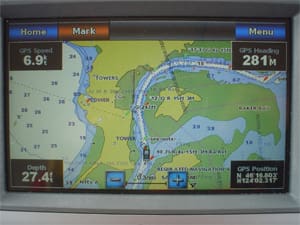I recently had the opportunity for a great voyaging adventure and thought I could mix a little business with pleasure by reporting on my experience with some new Garmin electronics. My friend Capt. Ralph Perez was the proud new owner of Western Flyer, a 1989 DeFever 41-foot trawler, which was docked in Portland, Ore. He had spent literally months away from his home in San Pedro, Calif., working to turn her into his dreamboat — and quite the dreamboat she was. One of his major projects was to replace her soft top with a custom hard top that made a drastic difference in her looks and utility, but this article is concerned with her suite of Garmin electronics and how well they performed.
When Captain Ralph was finally satisfied with the results of his labor and cash outlays, it was time to get underway for Western Flyer’s new home port at the newly rebuilt Cabrillo Bay Marina — a voyage of at least 1,000 nautical miles. I was one of three friends invited along for this fantastic adventure cruise. Western Flyer and her crew of four retired guys (aged 58-67) got underway for California on Wednesday, August 18. Counting two ports on our way down the Columbia River, the 98 miles to cross the infamous Columbia River Bar into open sea, we stopped at a total of seven ports. In order to make it to the Los Angeles area in nine days at seven to eight knots steaming speed, it was necessary to cruise overnight on several occasions. It was during those overnights when the boat’s GMR xHD dome radar and Garmin GPSMAP 741xs chartplotter really performed well.
Ralph installed the following new electronics onboard Western Flyer in anticipation of many great future cruises: Garmin GPSMAP 741xs, Garmin GHC 20 Marine Autopilot Control Unit, and the GMR xHD dome radar. All of this electronic gear made our voyage not only easier, but a lot safer as well. If you own a trawler and are serious about cruising, then I highly recommend using an autopilot. I realize that boaters must get the feel of the controls before really knowing the vessel; I tried helming the Western Flyer by hand and found it very difficult, especially in rough seas. The GHC 20 Marine Autopilot in concert with the GPSMAP 741xs did a superb job of steering the boat in the most economical way because it could make much smaller rudder adjustments, producing less drag and increased fuel efficiency.
When steaming in darkness or fog, radar is essential. The GPSMAP 741xs served as our radar monitor. The unit was fed radar data from the xHD dome radar. This combination provided radar ranges from 1/8 nm to 36 nm, but we found that for our purposes six to eight nm range was optimum. Because the autopilot was provided with data from the chartplotter and we were not conning the vessel by hand, we were actually standing radar watches to keep track of vessels that may pose a danger to our route. The two main checks that we made before assuming radar watch was to make sure the autopilot was on “follow route” mode, and that there were no contacts on the radar. We all stood these radar watches during darkness for two-hour intervals, which worked out well for a four-man crew.
One great feature about the 741xs chartplotter display is that it can operate in split-screen mode: one side was set up as a radar display, and the other side was set up as navigation route information. This information includes the following important parameters: distance to destination, arrival, off course, bearing, distance to next, time to next, waypoint velocity made good, next turn, GPS speed, GPS heading magnetic, depth, time of day, GPS position, and lat/long.
We found that this navigation data was important to our situational awareness, so we would have radar display on the left and the navigational data on the right.
Our watch routines worked very well for us and kept us safe; however, the routine onboard a boat must be determined by the captain because, like a pilot in command, he or she is ultimately responsible for the safe handling and navigation of the vessel. In closing, I would like to send mega kudos to the modern marine electronics manufacturers in general and to Garmin in particular. Clear skies and following seas to all!

